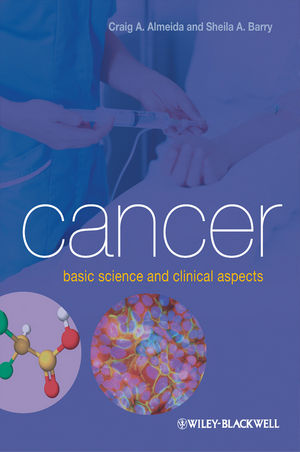Cancer: Basic Science and Clinical AspectsISBN: 978-1-4051-5606-6
Paperback
418 pages
January 2010, Wiley-Blackwell
 This is a Print-on-Demand title. It will be printed specifically to fill your order. Please allow an additional 10-15 days delivery time. The book is not returnable.
|
||||||
Acknowledgements.
1. The Basics of Cancer.
Cancer is a Complex Entity.
Cancer Through the Ages.
Modern Day Cancer Research and Treatment.
Prevalence and Mortality Varies With Each Cancer.
Risk Factors Have Been Identified.
Will Cancer be Conquered Within Our Lifetime?
2. Cells: the Fundamental Unit of Life.
Seven Hierarchal Levels of Organization.
Four Types of Macromolecular Polymers.
Cell Structure and Function.
Relationship Between Structure and Function is Important.
3. The Human Genome and Protein Function.
The Composition and Function of the Human Genome.
Having a Diploid Genome has its Advantages.
Proteins Carry Out Diverse Functions.
4. Cell Cycle, Oncogenes, and Tumor Suppressor Genes.
Cell Division in Germ-line and Somatic Tissues.
Consequences of Germ-line and Somatic Tissue Mutations.
Cell Division, Differentiation, and Maturation Occur to Form Functional Tissues.
Cell Division is Under the Regulation of the Cell Cycle.
Loss of Cell Cycle Control Results in Uncontrolled Cell Growth.
5. Tumor Formation, Growth, and Metastasis.
Tissue Changes that Occur in Response to Stimuli.
Feeding Tumor Growth by Angiogenesis.
Characteristics of Benign and Malignant Tumors.
Events that Occur During the Process of Metastasis.
6. Cancer Screening, Detection and Diagnostic Procedures and Tests.
Factors that Determine the Accuracy of a Diagnostic Test or Procedure.
Common Screening Tests.
Diagnostic Procedures for the Confirmation of a Disease.
Tumor Grade and Stage Factors into the Type of Treatment Regimen and Prognosis.
7. Cancer Treatment Modalities.
Surgery: the Oldest and Most Commonly Used Treatment Method.
Radiation Kills by Causing Extensive DNA Damage.
Cytotoxic Effects of Chemotherapeutic Drugs.
Side Effects and Risks From the Use of Cytotoxic Drugs.
Hormonal Deprivation Treatment: Used for Estrogen- and Androgen-dependent Cancers.
Can Cancer Growth be Controlled by Inhibiting Angiogenesis?
Additional Enzymes Targeted for Inhibition.
Biological Therapy Stimulates the Body’s Ability to Fight Cancer.
8. Breast Cancer.
Breast Cancer Statistics.
Women’s Breast Tissue: Unique in Structure and Function.
Causes of Breast Cancer.
Regular Examinations of the Breast are Important for Early Diagnosis.
What Follows a Positive Diagnosis?
Treatment Options are Unique for Each Individual.
Much has Been Accomplished, More Needs to be Done.
9. Ovarian Cancer.
Ovarian Cancer Statistics.
Structure and Function of Ovaries.
There are Three Tissue Categories of Ovarian Cancer.
Symptoms are Vague and Often Missed.
Certain Factors Have Been Associated with a Higher Risk.
Diagnostic Tools are Available But Not Always Used or Recommended.
Additional Procedures are Necessary to Confirm Suspicious Results or if there is Metastasis.
The FIGO System May be Used to Stage Ovarian Cancer.
Treatment Options for Ovarian Cancer.
Steps are Taken to Prevent Recurrence But Do Not Always Work When the Cancer is Advanced.
Much Needs to be Done in the Future.
10. Cervical Cancer.
Cervical Cancer Statistics.
Structure and Function of the Cervix.
Symptoms of Cervical Cancer.
Pelvic Examinations and Pap Tests Enable Early Detection.
Risk Factors for Cervical Cancer.
The HPV Test is a Vital Diagnostic Tool.
Additional Tests are Necessary to Examine the Cervix.
Treatment Depends on the Stage.
A Vaccine will Prevent Many Cases of Cervical Cancer.
11. Prostate Cancer.
Prostate Cancer Statistics.
Function of the Prostate Gland.
Certain Factors Influence the Development of Prostate Cancer.
Symptoms of an Enlarged Prostate.
Screening and Diagnostic Tests for Prostate Cancer.
There are Traditional and Unique Treatment Options Available.
Prostate Cancer Mortality Rates Have Decreased.
Much Attention is being Given to the Number One Cancer Affecting Men.
12. Testicular Cancer.
Testicular Cancer Statistics.
Structure and Function of Testicles.
There are Three Types of Testicular Tumors.
Risk Factors for the Disease.
Symptoms of Testicular Cancer.
Testicular Self-examination (TSE) is Recommended.
Blood and Imaging Tests are Used to Determine Diagnosis and Possible Metastasis.
Testicular Cancer Treatment Results in a High Cure Rate.
Causes and Treatments are being Studied.
13. Skin Cancer.
Skin Cancer Statistics.
Structure and Function of the Skin.
Three Types of Skin Cancer.
Risk Factors for Developing Skin Cancer.
Methods Used to Screen for Skin Cancer.
Surgery and Chemotherapy are Standard Treatments for Metastatic Skin Cancer.
What Happens After Skin Cancer Treatment.
Limited UV Radiation Exposure is the Number One Form of Prevention.
14. Lung Cancer.
Lung Cancer Statistics.
Lungs are the Site of the Exchange of Gases.
Risk Factors Associated with the Development of Lung Cancer.
Lack of Distinctive Symptoms Makes Early Diagnosis Difficult.
Lung Cancer is Often Diagnosed at an Advanced Stage.
There are Two Main Categories of Lung Cancer.
Three Traditional Therapies are Used in Lung Cancer Treatment.
Is There Discrimination in Cancer Research Funding?
15. Colorectal Cancer.
Colon and Rectum are the Last Two Sections of the Gastrointestinal Tract.
Risk Factors for Colorectal Cancer.
Screening Tests.
Treatment Options.
Targeted Therapies.
Screening Tests Performed After the Course of Treatment.
16. Leukemia and Lymphoma.
Leukemia Statistics.
Leukemia is a Cancer of the Blood Cells.
The Exact Cause of Leukemia is Unknown.
Early Symptoms of Leukemia.
Laboratory Studies are Necessary to Determine the Diagnosis.
There are Many Types of Leukemia.
Nonchemotherapeutic Options have Significantly Improved Survival Rates.
Lymphoma is a Malignancy of the Lymphatic System.
Hodgkin’s vs. Non-Hodgkin’s lymphoma.
Certain Risk Factors are Associated with an Increased Incidence of Lymphoma.
Diagnosing Lymphoma Involves Biopsies and Imaging Tests.
Lymphomas Must be Classified to Determine Appropriate Treatment.
Treatment Options Depend on the Type of Lymphoma, Stage, and Extent of Metastasis.
Glossary.
Index.
Companion website www.wiley.com/go/almeida/cancer



